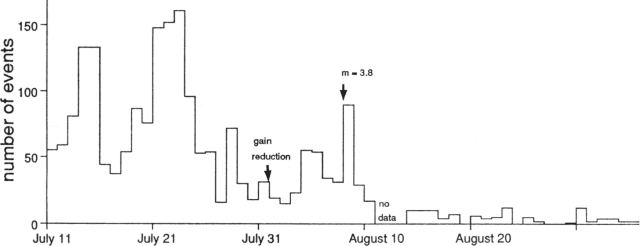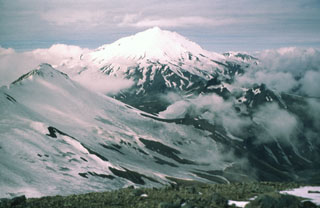Report on Dutton (United States) — August 1988
Scientific Event Alert Network Bulletin, vol. 13, no. 8 (August 1988)
Managing Editor: Lindsay McClelland.
Dutton (United States) Seismicity drops but remains in background
Please cite this report as:
Global Volcanism Program, 1988. Report on Dutton (United States) (McClelland, L., ed.). Scientific Event Alert Network Bulletin, 13:8. Smithsonian Institution. https://doi.org/10.5479/si.GVP.SEAN198808-312011
Dutton
United States
55.183°N, 162.276°W; summit elev. 1465 m
All times are local (unless otherwise noted)
"Seismicity near Mt. Dutton has continued at a low level since the last day of high activity on 8 August. Earthquakes have been high-frequency in character (i.e. not low-frequency volcanic events) and the best-located hypocenters lay at shallow depths (1-10 km) beneath the volcano's SE flank. Figure 1 shows three pulses of high activity followed by a few events/day through 4 September. This level of activity is still much higher than the background rate of a few events/year that existed before the swarm started in July."
 |
Figure 1. Number of events/day recorded at station DRRZ (28 km from the summit of Mt. Dutton). The data are not corrected for a reduction in gain on the helicorder on 1 August. |
Geological Summary. The Mount Dutton volcanic center east of Cold Bay near the tip of the Alaska Peninsula consists of a glacier-covered central lava dome complex. Early andesitic lava flows and late-stage dacitic domes have been partially removed by one or more edifice collapses about 5100-6800 years ago. Debris avalanches traveled west and south, reaching Belkofski Bay. The important regional fishing center of King Cove lies less than 15 km from the volcano, and the village's airstrip is built on top of the southern avalanche deposit. A steep-sided complex of lava domes forms the summit, and young block-and-ash flow deposits extend to the east. Two small unglaciated lava domes on the NE flank 3.5 km from the summit are also of Holocene age. Major earthquake swarms near the volcano were recorded in 1984-85 and 1988.
Information Contacts: John Taber, Lamont-Doherty Geological Observatory, NY.

